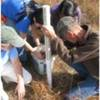Abstract
Extension agents with an interest in increasing the scientific and environmental awareness of their constituents may find an answer through a form of participatory scientific research known as citizen science. Citizen science uses volunteers of all ages, professions, backgrounds, and skills — often across broad geographic areas — to engage non-scientists in a variety of tasks, but most commonly data collection. This 5-page fact sheet informs potential citizen science practitioners of recent evaluations of citizen science programs. Looking closely at identifying appropriate tasks for volunteers, assessing data validity, and evaluating changes in volunteers’ knowledge and attitudes can help organizers avoid common pitfalls and develop citizen science programs most likely to succeed. Written by Luke Gommerman and Martha C. Monroe, and published by the UF Department of School of Forest Resources and Conservation, May 2012.
FOR291/FR359: Lessons Learned from Evaluations of Citizen Science Programs (ufl.edu)
References
Au, J., P. Bagchi, B. Chen, R. Martinez, S. A. Dudley, and G. J. Sorger. 2000. Methodology for public monitoring of total coliforms, Escherichia coli and toxicity in waterways by Canadian high school students. Journal of Environmental Management 58 (3):213-230. https://doi.org/10.1006/jema.2000.0323
Braschler, B. 2009. Successfully implementing a citizen-scientist approach to insect monitoring in a resource-poor country. BioScience 59 (2):103-104. https://doi.org/10.1525/bio.2009.59.2.2
Brossard, D., B. Lewenstein, and R. Bonney. 2005. Scientific knowledge and attitude change: The impact of a citizen science project. International Journal of Science Education 27 (9):1099-1121. https://doi.org/10.1080/09500690500069483
Canfield, D. E., C. D. Brown, R. W. Bachmann, and M. V. Hoyer. 2002. Volunteer lake monitoring: Testing the reliability of data collected by the Florida LAKEWATCH program. Lake and Reservoir Management, 18(1): 1-9. https://doi.org/10.1080/07438140209353924
Cohn, J. P. 2008. Citizen science: Can volunteers do real research? BioScience 58 (3):192-197. https://doi.org/10.1641/B580303
Couvet, D., F. Jiguet, R. Julliard, H. Levrel, and A. Teyssedre. 2008. Enhancing citizen contributions to biodiversity science and public policy. Interdisciplinary Science Reviews 33 (1):95-103. https://doi.org/10.1179/030801808X260031
Danielsen, F., M. Skutsch, N. D. Burgess, P. M. Jensen, H. Andrianandrasana, B. Karky, R. Lewis, J. C. Lovett, J. Massao, Y. Ngaga, P. Phartiyal, M. K. Poulsen, S. P. Singh, S. Solis, M. Sorensen, A. Tewari, R. Young, and E. Zahabu. 2011. At the heart of REDD+: a role for local people in monitoring forests? Conservation Letters 00 (1-10). https://doi.org/10.1111/j.1755-263X.2010.00159.x
Delaney, D. G., C. D. Sperling, C. S. Adams, and B. Leung. 2008. Marine invasive species: validation of citizen science and implications for national monitoring networks. Biological Invasions 10:117-128. Field Code Change https://doi.org/10.1007/s10530-007-9114-0
Evans, C., E. Abrams, R. Reitsma, K. Roux, L. Salmonsen, and P. P. Marra. 2005. The Neighborhood Nestwatch Program: participant outcomes of a citizen-science ecological research project. Conservation Biology 19 (3):589-594. https://doi.org/10.1111/j.1523-1739.2005.00s01.x
Fore, L. S., K. Paulsen, and K. O'Laughlin. 2001. Assessing the performance of volunteers in monitoring streams. Freshwater Biology 46:109-123. https://doi.org/10.1111/j.1365-2427.2001.00640.x
Galloway, A. W. E., M. T. Tudor, and W. M. Vander Haegen. 2006. The reliability of Citizen Science: A case study of Oregon White Oak stand surveys. Wildlife Society Bulletin 34 (5):1425-1429. https://doi.org/10.2193/0091-7648(2006)34[1425:TROCSA]2.0.CO;2
Gorman, J. 2001. Counting birds at the grassroots: Making a census into "Citizen Science," naturalists share their findings online. New York Times, Dec 13 2001, G1, G8.
Haag, A. 2005. A trip of a lifetime. Nature 435:1018-1020. https://doi.org/10.1038/4351018a
Lepage, D., and C. M. Francis. 2002. Do feeder counts reliably indicate bird population changes? 21 years of winter bird counts in Ontario, Canada. The Condor 104 (2):255-270. https://doi.org/10.1093/condor/104.2.255
Nerbonne, J. F., and K. C. Nelson. 2008. Volunteer macroinvertebrate monitoring: Tensions among group goals, data quality, and outcomes. Environmental Management 42:470-479. https://doi.org/10.1007/s00267-008-9103-9
Newman, G., A. Crall, M. Laituri, J. Graham, T. Stohlgren, J. C. Moore, K. Kodrich, and K. A. Holfelder. 2010. Teaching citizen science skills online: Implications for invasive species training programs. Applied Environmental Education and Communication 9:276-286. https://doi.org/10.1080/1533015X.2010.530896
Phillips, A. L. 2008. Of sunflowers and citizens. American Scientist 96 (5):375. https://doi.org/10.1511/2008.74.375
Sliverton, J. 2009. A new dawn for citizen science. Trends in Ecology and Evolution 24 (9):467-471. https://doi.org/10.1016/j.tree.2009.03.017
Trumbull, D. J., R. Bonney, D. Bascom, and A. Cabral. 2000. Thinking scientifically during participation in a citizen-science project. Science Education 84:265-275. https://doi.org/10.1002/(SICI)1098-237X(200003)84:2<265::AID-SCE7>3.0.CO;2-5

